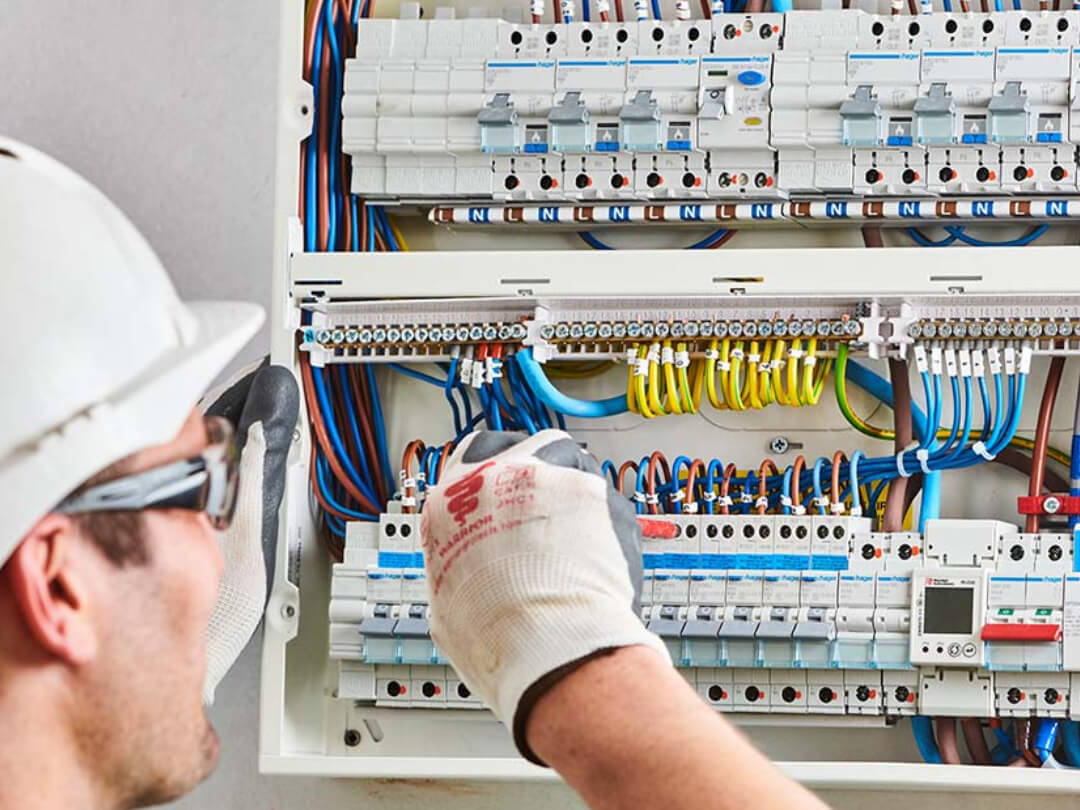What are Arc Fault Detection Devices?
AFDDs are protective devices installed in consumer units to provide protection from arc faults. They use microprocessor technology to analyse the waveform of the electricity being used to detect any unusual signatures which would signify an arc on the circuit. This will cut off power to the affected circuit and could prevent a fire. They are far more sensitive to arcs than conventional circuit protective devices.
Like a Residual Current Circuit Breaker (RCCB) or Residual Current Breaker with Overcurrent protection (RCBO), AFDDs usually incorporate a test button that can be operated by the end user to prove the mechanical operation of the device.
An introduction to AFDDs and their installation
AFDDs conforming to BS EN 62606 shall (must) be provided for all single-phase AC final circuits supplying socket-outlets with a rated current not exceeding 32 A.
However, the mandating of AFDDs is restricted to four types of installations where the effects of fire may lead to a higher risk of loss of life due to the increased number of people using the space(s) and/or increased damage to the building fabric as the geometry of the building promotes the “chimney effect.”
These are:
- Higher Risk Residential Buildings (HRRB)
- Houses in Multiple Occupation (HMO)
- Purpose-built student accommodation
- Care homes
Additionally, AFDDs are recommended on all single-phase AC final circuits supplying socket-outlets not exceeding 32 A in all other premises. For example, in a residential premises, AFDDs are not mandatory however may be extremely beneficial as there is a clear lack of maintenance and aged cabling present in dwellings which are likely to produce arc faults due to their prolonged operational lifespan.
A conversation explaining that AFDDs enhance the level of protection to the installation and are recommended as per the requirements needs to occur between the contractor and the electrical duty holder. If the duty holder is not in favour of following the recommendation, this decision needs to be recorded in writing and appended to the documentation provided to the duty holder following completion of the work.
What is a HRRB?
A HRRB is assumed to be residential buildings over 18 m in height or in excess of six storeys, whichever is met first. The parameters can be subject to change over time, as well as in risk management procedures adopted by fire and rescue services thus current legislation should be applied.
As the Building Safety Act received royal assent after the release of BS 7671: 2018 +A2 (2022), the definition within legislation may differ from that of BS 7671. It is therefore important for designers (and installers) to note that the definition in statutory legislation always takes precedence over a British Standard. As such, it is correct to add that any building which meets the height requirements (as mentioned above) and contains at least two residential units is classified as a higher-risk building in the Building Safety Act and is therefore subject to the requirements of Regulation 421.1.7.
This means that all mixed-use developments which contain two or more residential units, would also require AFDD protection on all single-phase AC final circuits supplying socket-outlets with a rated current not exceeding 32 A.
Impact on Projects
This is quite a significant change that levels the playing field for all contractors to include AFDD protection within their contracts / projects, particularly with the mandatory elements.
Some issues and considerations when using AFDDs
The size of the AFDDs may vary from manufacturer to manufacturer. Although this appears as a negative initially, it is actually quite beneficial. The variety provides designers / installers with the flexibility to use the most suitable arrangement for the installation, particularly for retrofit projects, where space is of a premium.
For example, AFDDs can come as individual monitoring units that can be attached to either an MCB or RCBO. They also are available as single, double, or indeed triple module, with either an MCB, RCD, or RCBO pairing. This adaptability allows designers to select the most appropriate solution, when taking account of aspects such as breaking capacity.
Contractors also need to be aware that the status indicators for AFDDs are often different colours (depending on manufacturer), this means that solid red, amber, or green colour can indicate “normal” status. In fault conditions, the indications also differ by either being a solid amber light or a series of flashing lights, the meaning of which can only be found with reference to the manufacturer’s instruction label/leaflet.
Following a disconnection, the fault sequence is only repeated once, upon initial reset of the device. If the client or ordinary person performs the initial reset, the information could be lost, making fault finding difficult. However, there are a number of manufacturers who are looking to build intelligence into their devices, with one benefit being convenient recall/ history.
In summary
AFDDs are mandated on the single-phase AC final circuits supplying socket outlets with a rated current not exceeding 32 A but only if this circuit is contained within one of the four installation types mentioned previously.
For all other locations (and circuit types), AFDDs are recommended, however, the choice is made by the electrical duty holder of the respective installation with input from the electrical contractor (as the skilled person).
Recommendations within BS 7671 should be adhered to, as they have been identified as options that are particularly suitable to meet the requirements. This doesn’t exclude other options, but it does mean that contractors must demonstrate how the requirement is being met.
Finally, there are a few nuances associated with each AFDD manufacturer in terms of the size of devices and indicator lights which may vary in hue. This flexibility is actually welcome however does require particular attention be paid to the manufacturer’s instructions/literature.
How do I get started with online electrical training?
There’s never been a better time to invest in developing your electrical skills. Today, online electrical training is the fastest, most convenient and cost-effective way, to gain in-demand electrical skills. XS Training Ltd is established as a leading UK online electrical training provider.
Why wait? It’s the ideal time to get started training for your NVQ today! Call us on 0800 170 0294, or click here to get your questions answered.






